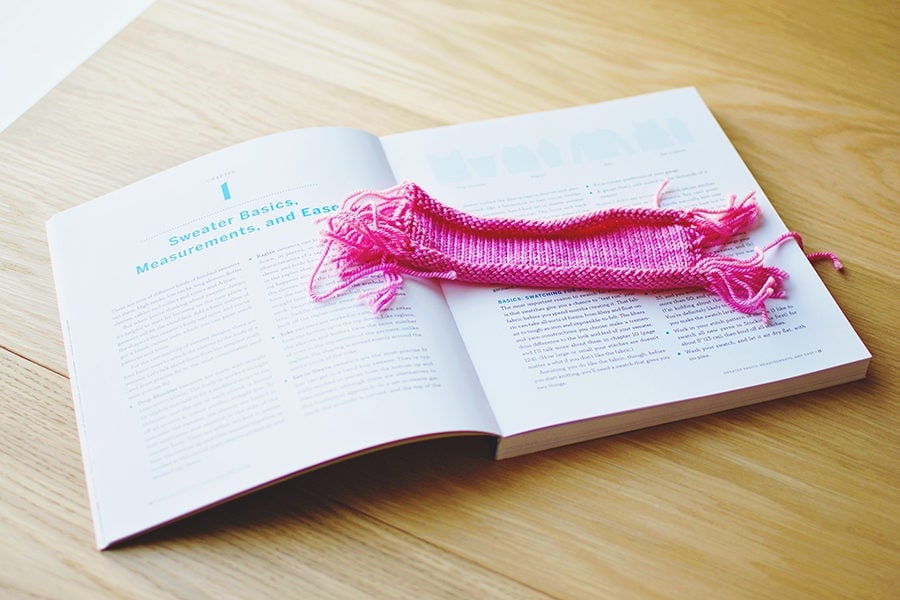This past year, it’s been my goal to push out of my knitting comfort zones. I’ve never really been a garment knitter, opting for knitting baby sweaters since sizing is more flexible, has less shaping calculations, and babies would look cute even if you put them in a potato sack. I have knitted myself one pullover sweater, and the results were not what I had imagined. The yarn was thick and inflexible, and the sweater itself was too tight on my body and a lot shorter than I like sweaters to be. It still sits in a plastic tub with my other knitwear under my bed; a subtle reminder of my shortcomings as a knitter every time I grab a shawl.
This year, however, I’ve confronted my creative fears and tried adult sweaters again. I tested the waters this summer by knitting the Like a Cloud Cardigan by Joji. It was a beautiful, flowy piece that required no shaping and I got so many compliments on it at Knit City — a great great boost to my confidence! So, I pushed forward and searched for a sweater I could knit for my husband as a sort-of Christmas gift (he knows about it and it probably won’t be completed by Christmas, but it’s the thought that counts, yes?).

I spent over an hour on Ravelry and nothing I saw seemed to fit the bill. Frustrated, I Googled “how to make a sweater” and Amy Herzog’s blog post on her latest book, Ultimate Sweater Book popped up. My true desire is to make a custom sweater pattern myself, but I haven’t knit enough sweaters to know the construction well enough to do so. This was a good solution! Happily, Amazon delivered the book to my door the next day.
The Ultimate Sweater Book is divided into four sections: Basics, Adjustments, Embellishments, and The Garments. In the Basics section, Amy goes over how to take proper measurements, measure gauge, and draft your own sweater pattern in Drop Shoulder, Raglan, Yoke, and Set-In-Sleeve styles. In Adjustments, the reader is exposed to all the changes you can make to the body, sleeves, and neck of a sweater to customize it more to your preference. The Embellishments section offers tips on the advantages and disadvantages of certain yarns, stitch patterns, different edgings, and how to add things like pockets and buttonholes. The Adjustments and Embellishment sections include a couple sweater “recipes” where Amy has changed the basic sweater patterns included in the first section of the book. The Garments section includes eight patterns by Amy that put into practice all the techniques discussed in the book.
Through reading Amy’s book, it’s obvious that she is a “Fit Master” in the knitwear design world. She gives excellent direction on how to measure yourself properly to choose a sweater size that is best for you and how to make necessary adjustments in order get a garment that fits the way you like it. There are also many helpful formulas that I can see myself referring to over and over again in the future.
Another aspect of this book I found helpful was how much Amy focused on the fabric certain materials produce and what fabric you should aim for depending on the style of sweater you wanted. One of the most helpful tips was the “poke test,” which seems like an excellent way to ensure the integrity of your fabric so you don’t end up with an unintentionally droopy sweater. I liked that Amy ignores trying to match the gauge set on a pattern because it’s not the gauge that matters, but the fabric you create. You should adjust the pattern to your gauge, not adjust your gauge to fit the pattern. I think this is an excellent strategy as it eliminates the frustration of trying to match a stranger’s knitting style and makes you a more knowledgeable knitter in the process as you learn how to change a pattern to fit you.

If you are not confident enough to write your own basic sweater pattern, Amy has provided a basic sweater and cardigan pattern in four styles (Drop-Shoulder, Raglan, Yoke, and Set-In Sleeves) in 12 sizes and 3 gauges. The directions for many of the patterns are only for seamed bottom-up constructions, with little mention of how to rework the patterns in the round or top-down. For some knitters, a casual mention of how to rework a pattern is enough, but for someone new to changing patterns, it can be a confusing and daunting task. I felt like I needed a bit more hand-holding from the author in some part of the book, and would have liked more diagrams for some techniques mentioned. I am a visual learner and find photo tutorials extremely useful so the mostly written button technique section was a little confusing, but I found the pocket tutorials very useful with excellent visuals.
Overall, Amy’s book is an excellent resource for those wanting to knit a custom fit sweater, with a lot of valuable information on fabric, shape, fit, and alterations. It is a solid addition to my knitting book collection and I have a new goal to attempt her cozy cabled Campfire Cardigan once I get a few basic sweaters under my belt. &


